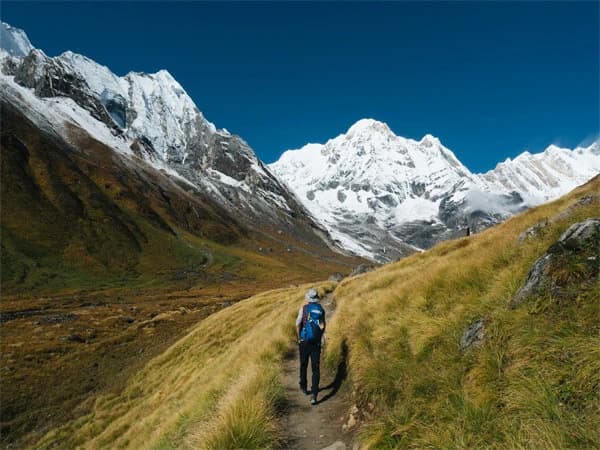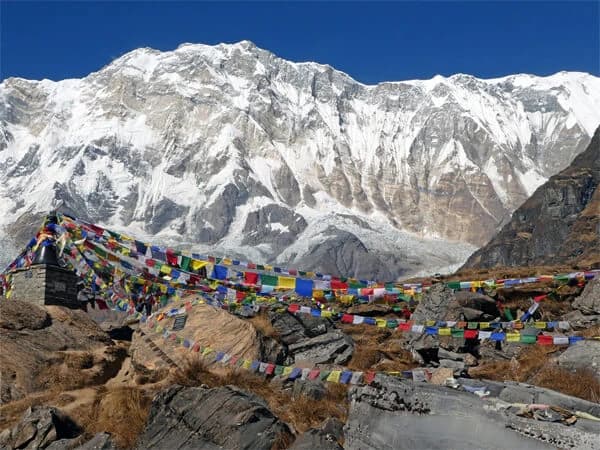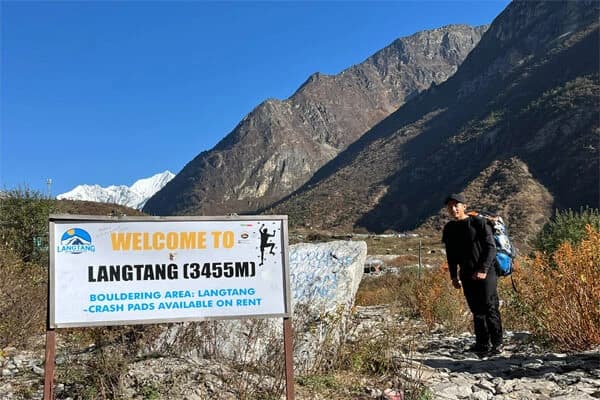Hiking to Annapurna Base Camp is among the most breathtaking and fulfilling experiences one can have in Nepal. This hike immerses you in the heart of the Himalayas, surrounded by towering snow-capped mountains. However, the combination of local culture, natural beauty, and individual accomplishment is what really sets it apart, not simply the view.
For those who seek a genuine mountain experience without having to be skilled climbers, the Annapurna Base Camp trek, or ABC trek, is ideal. Along the way, you'll see serene forests, hospitable communities, hot springs, and some of the world's most breathtaking mountain vistas.
There is something for everyone on this trek, regardless of experience level. You hear prayer flags flapping in the wind, stroll through traditional Gurung villages, and gradually ascend from verdant valleys to snow-capped summits.
Reaching the Annapurna Base Camp is a dream come true for many tourists. This trek should be on your bucket list if you enjoy hiking, appreciate the outdoors, and want to feel a connection to the mountains. It is a life-changing experience rather than just a walk.
Breathtaking Mountain Views
The breathtaking mountain views are one of the main reasons why hikers adore the Annapurna Base Camp climb. To appreciate the Himalayas' splendor, you don't need to be a mountaineer or scale perilous peaks. Without the need for ropes, ice axes, or climbing expertise, the ABC trip allows you to get up close and personal with some of the world's tallest and most stunning mountains.
See Annapurna I Up Close
At 8,091 meters, Annapurna I is the tenth highest mountain in the world. You will be standing at the base of the peak on this hike, only a few kilometers away from its enormous snow-capped face. You won't be able to express how it makes you feel.
Annapurna Base Camp offers a 360-degree mountain vista, unlike Everest, where the base camp doesn't provide much of a mountain view. There are towering, snow-capped peaks all around you, and they seem quite close. It's like to being in a mountain stadium.
Machhapuchhre: The Holy “Fishtail” Mountain

Seeing Machhapuchhre, commonly referred to as "Fishtail" due to its unusual twin peak, is one of the trek's highlights. This mountain is even more extraordinary because it is considered sacred by the locals and is off-limits to climbers.
You may obtain breathtaking views of Machhapuchhre from various locations along the trek, particularly from Jhinu Danda, Chhomrong, and Himalaya. It appears enchanted at sunrise or sunset and rises dramatically over the woodland.
Unmatched Sunrise and Sunset Moments
You can witness nature's greatest performance up close if you hike early in the morning or arrive at a resort right before nightfall. The peaks of Hiunchuli, Machhapuchhre, and Annapurna South glow pink, orange, and gold when the sun strikes them. You will always remember these tranquil, serene times.
The atmosphere in the highlands is unique, even on overcast days. Sunbeams may be visible through the mist, or clouds may be seen sweeping across the valleys. Every day offers a fresh perspective.
No Need to Go Extreme
The nicest aspect is that you can view all of this without having to ascend to 5,000 or 6,000 meters. With the proper pace and acclimatization, the 4,130-meter elevation of Annapurna Base Camp is low enough for most people to manage while yet feeling like a true adventure.
The ABC trek is an excellent option for novice high-altitude hikers who wish to see expansive mountain vistas without endangering their health or well-being.
The Perfect Himalayan Introduction
Annapurna Base Camp is the ideal starting point if you've always wanted to see the Himalayas up close but aren't prepared for Everest or more isolated hikes. It offers everything from rugged peaks and glaciers to cozy sunsets and serene valleys, and it's safe, beautiful, and incredibly fulfilling.
Rich Cultural Encounters Along the Way
The incredible people and culture you encounter along the way are just as much a part of hiking to Annapurna Base Camp as the mountains themselves. The Annapurna region is home to many historic communities, hospitable residents, and distinctive lifestyles that date back hundreds of years.
Meet the Gurung and Magar People
You will come across the Gurung and Magar communities as you go through villages like Ghandruk, Chhomrong, and Landruk. This Annapurna region of Nepal is home to these major ethnic groups. They are renowned for their rich cultural traditions, close ties to the land, and kind hospitality. Trekkers are frequently greeted by the Gurung with broad smiles, and if you're lucky, you might be asked to participate in an evening local song or dance. These peasants are very proud of their history and many have served in the Indian or British Gurkha army.
Traditional Villages and Homes
These mountain communities have traditional architecture, with timber beams, slate-tiled sloping roofs, and stone walls. There are flower gardens, little courtyards where people congregate, and prayer flags flapping in the wind in many homes.
You may get a close-up look at Himalayan culture by strolling through these settlements. Locals can be seen cultivating crops, gathering firewood, or tending to buffalo and goats. It is a tranquil way of living that is intimately connected to nature.
Stay in Family-Run Teahouses
Staying at teahouses is one of the best ways to explore the culture. The trail is lined with these tiny, family-run lodges. They offer a warm place to sleep, food, and basic lodging. The majority are run by local families that will make you feel welcome, cook for you, and converse with you.
You can sample traditional Nepali dishes like momos (dumplings), Tibetan bread, or dal bhat (lentil soup with rice and veggies) for dinner. Along with other hikers, you can gather around the stove and hear your hosts' tales of mountain life.
Buddhist Influence and Prayer Flags
You'll observe the region's significant Buddhist influence as you ascend higher. You will come across prayer wheels, chortens (little shrines), and mani walls (stone walls etched with prayers). Over bridges and ridgelines, vibrant prayer flags float in the breeze, sending prayers to the sky. These symbols are rich in meaning in addition to being attractive. They honor the mountains and remind hikers that many people hold this land in high regard.
A Cultural Journey as Well as a Trek
There is more to hiking to Annapurna Base Camp than just the physical trek. It's an opportunity to get knowledge from those who live in these mountains. Their kindness, traditions, and stories stay in your heart long after you’ve returned home. This cultural connection makes the trek truly unforgettable, and is one big reason why the ABC trek should be on your bucket list.
ABC Trek Through Diverse Natural Landscapes
It's not just about the mountains when hiking to Annapurna Base Camp; it's also about the breathtaking scenery that varies every day. You pass through a variety of settings along the trail, each one more unique than the last.
You begin the hike by traversing verdant woodlands teeming with rhododendron trees, bamboo groves, and vibrant birds. You pass peaceful towns, rice terraces, and flowing rivers as you ascend higher. In the middle of untamed nature, you'll hear waterfalls and traverse wooden bridges. Jhinu Danda is a unique location where you may unwind in a natural hot spring by a river. It is a fantastic method to give your weary legs a break before tackling the climb.
The landscape changes more as you ascend. The air cools, the trees get smaller, and snow-capped peaks emerge. You are encircled by massive mountains on all sides when you eventually arrive at Annapurna Base Camp. It is like standing in a beautiful bowl of snow. Every day is fascinating and new because of this variation. It is not a single path; rather, it is a journey through numerous universes that will never be forgotten.
Annapurna Base Camp Trek for Beginners
The Annapurna Base Camp journey is ideal for novice hikers, which is one of the main reasons it should be on your bucket list. To complete this walk, you don't need to be an expert mountain climber or extremely fit. Since it's a modest journey, anyone with a moderate level of fitness may do it if they prepare psychologically and go slowly.
How to hike to Annapurna Base Camp

You'll encounter a lot of other hikers on the well-marked and often used trail. Depending on the route they choose, most individuals do the ABC journey in 7 to 10 days. About 4-6 hours will be spent walking each day, with time for relaxing, observing the scenery, and taking photos.
Food and bulky camping equipment are not necessary to bring. There are many teahouses along the trail, which are tiny lodges where you may rest, eat hot food, and socialize with other hikers. Simple yet comfortable accommodations and local Nepali food, such as dal bhat, noodles, soups, and tea, are provided by these lodges.
At 4,130 meters, Annapurna Base Camp is the trek's highest point. Although it's high, if you take it carefully and give your body time to acclimate, it won't be dangerous. Most people have mild altitude-related symptoms, such as fatigue or shortness of breath, but these normally go away with rest and adequate fluids.
Therefore, the ABC trek is among the most beginner-friendly high-altitude treks in Nepal if you've never gone on a major trip but have always wanted to walk in the Himalayas. Without taking you too far from your comfort zone, it offers you adventure.
Best Time to Hike Annapurna Base Camp
The spring (March to May) and fall (September to November) seasons are the best times to hike Annapurna Base Camp. The best weather, clear skies, and safest hiking conditions are available throughout these months.
Nepal's national flower, the rhododendron, blooms in the springtime, filling the forests. Annapurna I, Machhapuchhre (Fishtail), and other snow-capped peaks are frequently seen in clear, lovely views. Additionally, trekking is more comfortable during the day because it is warmer.
Autumn follows the monsoon season. The sky is often extremely clear, the temperature is pleasant, and the dust has been wiped away by the rain. Since this is the busiest time of year for hiking, trekkers from all over the world frequently clog the paths and tea houses.
Trekking is feasible during the monsoon season (June to August) and winter (December to February), however these times of year present difficulties. While the monsoon season brings rain, leeches, and slick paths, winter brings snow and frigid temperatures at higher elevations. Experienced hikers who don't mind unpredictable conditions are better suited for these off-seasons.
What to Pack for Annapurna Base Camp Trek
The key to packing for the ABC trekking journey is to be ready for any weather conditions. Your clothing and equipment should be able to withstand both hot and cold temperatures because the trail begins in pleasant, lush valleys and gradually ascends into chilly alpine regions.
Concentrate on sensible layers rather than cramming too much. In this manner, you can adjust your wardrobe according to the weather. You’ll also want to make sure you have things that keep you dry if it rains, and warm during chilly mornings and nights.
Footwear is especially important. You’ll be walking for several hours each day, so your shoes should be comfortable, strong, and able to handle different types of trails from mud to stone steps to snow.
Don’t forget simple but important things like sun protection, a reusable water bottle, and something to help you purify water. Many trekkers also bring snacks, first aid, and a small day bag for daily use. If you don’t want to bring everything from home, you can rent or buy most trekking gear in Kathmandu or Pokhara at good prices.
Annapurna Base Camp Trekking Itinerary
Depending on your starting place, physical level, and pace, the majority of Annapurna Base Camp hikes itinerary should be 7 to 11 days. Basically Annapurna base camp trek 7 days itinerary, Annapurna base camp trek 10 days itinerary and Annapurna base camp trek 15 days itinerary is popular itinerary for traveler. Starting from a location close to Pokhara, the typical route gradually ascends via picturesque mountain villages and thick woods.
Annapurna Base Camp Trekking Route
After making stops at well-known locations including Ghandruk, Chhomrong, Bamboo, and Deurali, you will arrive at the breathtaking base camp at 4,130 meters. The view from Annapurna Base Camp is stunning; it will seem as though you are standing inside a mountain bowl with towering peaks on all sides.
Poon Hill, a viewpoint renowned for its sunrise views of the Annapurna and Dhaulagiri ranges, is another destination that some visitors combine with the trip. This is a fantastic addition if you have extra days.
Teahouses, which are little guesthouses managed by neighborhood families, are where you will spend the night. Five to seven hours of walking are typically included each day, followed by delicious meals, a cozy fire in the dining area, and relaxation. You can hike alone, in a group, or with a guide and porter (which is advised). For all types of travelers, we provide friendly and well-run tours.
Affordable ABC Trek in Nepal
If you want a big adventure without breaking the bank, hiking to Annapurna Base Camp is the ultimate trip. This walk is incredibly inexpensive when compared to other well-known treks throughout the world, such as the Kilimanjaro in Africa or the Inca Trail in Peru.
Annapurna Base Camp trekking cost 2026/027
Annapurna base camp trek cost depends on various subject. Here's a rough estimate of what you could spend:
- Annapurna Base Camp Trekking Permits Cost: TIMS card and the Annapurna Conservation Area Permit (ACAP). They cost about $40 to $50 USD when combined.
- Annapurna base camp trekking Accommodation cost: Nightly rates at teahouses often range from $5 to $10 USD. Some even give out accommodations if you have breakfast and supper there.
- Annapurna base camp trekking Food cost : Prices range from $5 to $10 USD for meals such dal bhat, noodles, and tea. Spend between $20 and $25 USD a day on meals.
- Annapurna Base camp trekking Porter (optional) and guide cost: A porter costs about $20 to $25 USD per day, and a guide costs about $25 to $75 USD per day. Employing them facilitates your journey and boosts the local economy.
Annapurna Base Camp Trek packages:
Depending on how many days you trek to Annapurna base camp, whether you hire a guide or porter, and your desired level of luxury Annapurna Base Camp Trek with guide can cost anywhere between $1500 and $3000 USD.
Affordable Annapurna Base Camp Trek packages that cover transportation, permits, guides, and other expenses are available from our company, Nepal Trekking Routes. Making a reservation with a reputable local business also contributes to a fun and safe trip.
The benefits are enormous for the money you invest. It's worth every penny for the breathtaking Himalayan vistas, culturally rich experiences, serene paths, and the satisfaction of arriving at base camp.
Safety and Support During Teahouse Trek Nepal
When hiking in the Himalayas, many individuals are concerned about their safety, particularly when they are heading to high altitudes like base camps. However, one of Nepal's most popular and safest hikes is the Annapurna Base Camp trip.
Annapurna Base Camp Trek Tour From Pokhara
It is simple to start the Annapurna Trek. The hike often begins in Pokhara, a stunning city with excellent bus and airline connections from Kathmandu. The trailhead, which is typically Nayapul, Ghandruk, or Jhinu Danda, is only a short drive from Pokhara.
The track is very well-developed. You never have to trek far to find food or shelter because there are teahouses and lodges every few hours. Additionally, there are stores that sell water, snacks, and trekking supplies if necessary.
Along the journey, there is a lot of local support. Local villagers, porters, and guides are accustomed to assisting visitors. You may always stop early for the day if you're feeling ill or exhausted, or you can even hire a porter to assist you carry your suitcase. In the event of an emergency, rescue services are available, and you can use Wi-Fi or a local SIM card to phone for assistance from most locations.
Any Himalayan climb carries the danger of altitude sickness, but the ABC trek is typically doable because to its moderate ascent and low elevation. You should be alright as long as you take one or two acclimatization days, walk gently, and drink lots of water.
The Annapurna Base Camp hiking provides the ideal balance of safety and adventure, making it ideal for those who wish to feel bold but exercise caution.
The Emotional High During Base Camp Trek in Nepal

Reaching Annapurna Base Camp has a certain allure. You finally find yourself in a broad, open valley with snow-capped peaks on all sides after days of traversing forests, rivers, stone steps, and mountain communities. You seem to have entered an other universe, one that is peaceful, beautiful, and powerful.
The tenth-highest mountain in the world, Annapurna I, is located in the middle. Additionally, you will view Gangapurna, Hiunchuli, Machhapuchhre (Fishtail Mountain), and other places. Like guardians of the Himalayas, these giants rise above you. It seems as though you could reach out and touch the mountains because of how close up the vistas are.
Being in base camp is more than simply a picture opportunity. It's a time of intense feeling and introspection. A lot of people laugh, weep, or just sit quietly. You recall how far you've come in life as well as on the route. You feel fully alive, thankful, and proud.
While gazing at the summits, some hikers set up a prayer flag, snap a group portrait, or simply enjoy a cup of tea. Others say a silent prayer or write a letter. Everybody has a different experience with it. Climbing the mountain is not the goal of getting to Annapurna Base Camp. It's about making a connection. And you will always remember that moment.
How Difficulty is Annapurna Base Camp Trek?
This is one of the most frequently asked topics, and the good news is that most people find it easy to answer. Although you don't need any specialized climbing skills to complete the Annapurna Base Camp Trekking, you do need to be reasonably fit and mentally prepared.
There are several stone steps along the hillsides. Even if some days are lengthy and exhausting, you are free to take breaks and move at your own speed. Many novices successfully finish the trek, particularly with the assistance of a porter and guide. The altitude is the biggest obstacle. At 4,130 meters, the base camp requires time for your body to acclimate to the low altitude. This is why it's crucial to take your time and stick to the schedule.
The Annapurna base camp trek difficulty may also be impacted by the weather. The trail may become more slick or uncomfortable if you're trekking during the monsoon or winter months. However, most people find the walk difficult but manageable and highly rewarding if they have the proper equipment, mindset, and preparation.
Tips for Hiking Pokhara to Annapurna Base Camp
The ABC hike is a true mountain adventure, despite being categorized as moderate. The following helpful advice will increase the safety and enjoyment of your trek:
- Take your time and move slowly. This is the ideal way to enjoy the trail's beauty without getting altitude sickness.
- Consume a lot of water each day. High elevations frequently cause dehydration.
- Observe local traditions and customs. Numerous cultural communities are traversed along the walk. Polite conduct and a smile go a long way.
- Take days off if necessary. It's not urgent to get to base camp. Pay attention to your body.
- A few weeks prior to your vacation, begin your training. Stair climbing, modest trekking, and daily walking will help prepare your legs.
- Keep some cash on hand. The trail does not have ATMs.
- Obtain travel insurance for Annapurna Base Camp trek that includes coverage for potential rescue and high-altitude treks.
Enjoying the trip is the most crucial thing. Don't only concentrate on getting to base camp. There is beauty and significance in every step.
Alternative Routes for Himalaya Hiking Experience
The Annapurna Sanctuary trek and the Ghorepani Poon Hill and ABC trek are great options if you're searching for other trekking routes to add to your bucket list. The shorter and simpler Ghorepani Poon Hill Trekking is well-known for its vistas of the Annapurna and Dhaulagiri ranges at daybreak. Families or beginners will love it. The Annapurna Sanctuary journey reaches Annapurna Base Camp after taking you far into the Himalayas. It has cultural appeal, varied terrain, and breathtaking beauty. Both treks are great for anyone who wants to experience Nepal's natural charm since they are stunning, safe, and full of memorable mountain moments.
Some of Frequently Asked Question
Do I need a visa to travel to Nepal for the Annapurna Base Camp trek?
Yes, in order to enter Nepal, most visitors must have a valid visa. A tourist visa can be obtained online in advance or upon arrival at Kathmandu's Tribhuvan International Airport. Typically, the visa is valid for 15, 30, or 90 days. Verify that your passport will be valid for at least six months after the date of your arrival.
How do I get from Kathmandu to the start of the Annapurna Base Camp trek?
The majority of visitors begin their journey at Pokhara, the entry point to the Annapurna region, from Kathmandu. You can travel via private vehicle, domestic airplane (25 minutes), or tourist bus (6–8 hours). Depending on the route you choose, you will drive from Pokhara to a beginning place such as Nayapul, Ghandruk, or Kimche.
Is it easy to travel by bus or should I fly to Pokhara?
A tourist bus is the most affordable and well-liked option if you're on a tight budget. However, a flight is quicker and more pleasant, albeit a little more costly, if you want to skip long, rough roads and save time. Both options are popular with trekkers and are safe.
Can my trekking company handle visas and transportation?
Indeed! Our company, Nepal Trekking Routes, can aid with internal flights, transportation to Pokhara, airport pickup, and, if necessary, visa processing. Your trip will go more smoothly and you'll save time by not having to plan everything yourself.
Conclusion: Hiking to Annapurna Base Camp
Hiking to Annapurna Base Camp is a journey into the heart of Nepal, not just a trip through the mountains. It offers a combination of all the things a trekker may want, including serene forests, rich cultural villages, breathtaking mountain views, and the warm faces of locals.
You can do it even if you are a beginner. Anyone who likes nature and adventure may make it to Annapurna Base Camp and experience the wonder of being in the heart of the Himalayas with the right direction, preparation, and a little willpower.
This is the trek you should put on your bucket list if you can. And when you are ready to go, book ABC Trek with Nepal Trekking Routes. We are here to help you every step of the way.

.webp&w=3840&q=75&dpl=dpl_4U3CaZUV3Y5iKdBNPJmVMATJy3AB)








